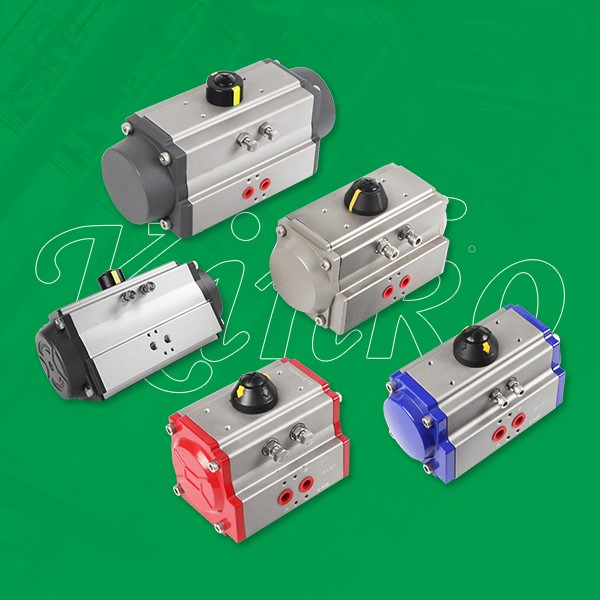
I. Core application scenarios of the new energy industry
1. Hydrogen energy industry chain
Storage and transportation: The pneumatic actuator is used to control the high-pressure hydrogen valve, which needs to meet the requirements of -253℃ ultra-low temperature environment and zero leakage. For example, Zhejiang Walsh's AT series actuators achieve rapid cut-off (response time < 1 second) in hydrogen energy storage and transportation to ensure safety.
Refueling station: The double-acting actuator drives the high-pressure hydrogen filling valve, which needs to pass the SIL3 function safety certification to adapt to high-frequency opening and closing (life of more than 1 million cycles).
2. The field of nuclear power
Cooling water system: The fork-type actuator (such as Jiangsu Furotec DRG series) has an output torque of 240,000N·m, replacing imported products and meeting the high safety level of nuclear power (such as the AP1000/CAP1400 project).
Steam pipeline control: The gear rack actuator is adapted to high-temperature and high-pressure working conditions, and is connected to the valve through the ISO5211 standard interface to ensure sealing.
3. Lithium battery production
Fire protection system: The single-acting spring reset actuator (such as Wofei Kai ATE series) controls the fire valve in the lithium battery plant, and automatically closes when the gas is cut off to prevent the electrolyte from leaking.
Slurry conveying: The explosion-proof actuator is adapted to the non-lubricated slurry medium, and the torque increases the safety factor by 30% to avoid jam.
4. Photovoltaic and wind power
Tracking bracket: parallel pneumatic claws adjust the angle of the photovoltaic panel, requiring high-precision positioning (±0.1°) and IP65 protection level to adapt to the sand and dust environment.
Variable paddle system: low-power actuator drives the fan blades, reduces energy consumption by optimizing the air path design, and matches the power supply needs in remote areas.
II. Key elements of selection
1. Torque and safety factor
Basic torque calculation: the opening and closing torque is determined according to the valve caliber, pressure level and medium viscosity. For example, when controlling the 200N·m non-lubricated steam balloon valve, it is necessary to increase the safety factor by 25% and choose an actuator with 250N·m output torque.
Extreme working condition compensation: the particle medium needs to increase the safety factor by 100%, and the corrosive medium needs to be made of Hassex alloy or titanium alloy.
2. Select the actuator type
Double-acting (ATD series): The gas source is directly driven, suitable for high-frequency operation (such as hydrogen energy filling station), but it cannot maintain its position when the gas is cut off.
Single-acting (ATE series): Spring reset, suitable for safe return scenarios (such as nuclear power fire valves), but the output torque is limited by the spring.
Fork type: The torque curve matches the large-caliber butterfly valve, which is suitable for the ultra-low temperature environment of nuclear power.
3. Accessories and intelligent configuration
Control class: NAMUR interface solenoid valve adapts to the field bus (such as Profibus-PA), and the intelligent locator supports the HART protocol to achieve remote adjustment.
Feedback class: The limit switch (such as Omron D4V series) provides a valve opening and closing signal, and the position transmitter outputs 4-20mA current.
Safety category: The manual emergency operation mechanism complies with the ISO13849 standard, and the air filter pressure reducing valve (such as Festo FRL series) ensures the cleanliness of the air source.
4. Environmental adaptability
Low-temperature environment: -40℃ to +80℃ wide temperature actuator is selected, and the grease is made of polyurea-based material to avoid solidification.
Explosion-proof requirements: Hydrogen energy scenarios require ATEX Zone 2 certification, and the actuator shell protection level is IP67.
Corrosion resistance: The coastal photovoltaic project uses a 316L stainless steel actuator, and the surface coating has passed the NSS 1000h salt spray test.
III. Selection process and case
1. Requirements analysis
A hydrogen energy storage and transportation project: valve torque 300N·m, medium -253℃ liquid hydrogen, safety level SIL3.
Solution: Zhejiang Walsh ATD150 actuator (output 340N·m at 5bar pressure), equipped with low-temperature sealing ring and NAMUR interface solenoid valve, which has passed TÜV certification.
2. Cost-effective optimization
A photovoltaic tracking bracket project: 5,000 sets of actuators are required, and the budget is limited.
Solution: Adopt Yadeke AT series actuators (life of more than 1 million times), the price is only 60% for imported brands, and the comprehensive cost is reduced through batch delivery.
3. Intelligent upgrade
A nuclear power project: remote monitoring and predictive maintenance of valve status is required.
Solution: Integrate Festo SVP intelligent locator, upload running data to SCADA system through IO-Link communication, and predict faults in combination with AI algorithms.
IV. Future Trends
1. Material innovation: Carbon fiber-reinforced composite actuators reduce weight by 30%, which is suitable for drone inspection scenarios.
2. Energy efficiency: Oil-free lubrication technology reduces energy consumption by 20%, in line with EU ERP directives.
3. Digital integration: The 5G module supports the seamless docking of the actuator with the industrial Internet platform (such as Siemens MindSphere) to achieve full life cycle management.
Conclusion: The demand for pneumatic actuators in the new energy industry shows the trend of "extreme condition adaptation + intelligence + high cost performance". When selecting the model, it is necessary to combine torque calculation, safety coefficient, environmental adaptability and accessory configuration, and give priority to domestic high-end products that have passed SIL3, ATEX and other certifications (such as Walls and Frotec) to achieve technical substitution in key fields such as nuclear power and hydrogen energy.
 Service Hotline:
Service Hotline: E-Mail:
E-Mail: Chinese
Chinese
 English
English
 한국어
한국어
 Español
Español






